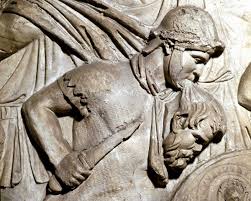Stamp: "Saint Hermes", painting by Conrad Laib (Austria 1972)
"Saint Hermes", painting by Conrad Laib (Austria 1972)
21 August (Austria ) within release Exhibition ""Late Gothic in Salzburg"" goes into circulation Stamp "Saint Hermes", painting by Conrad Laib face value 2 Austrian schilling
| Stamp "Saint Hermes", painting by Conrad Laib in catalogues | |
|---|---|
| Michel: | Mi:AT 1393 |
| Yvert et Tellier: | Yt:AT 1221 |
Stamp is vertical format.
Stamp "Saint Hermes", painting by Conrad Laib it reflects the thematic directions:
An exposition, in the most general sense, is an organized presentation and display of a selection of items. In practice, exhibitions usually occur within museums, galleries and exhibition halls, and World's fairs. Exhibitions can include many things such as art in both major museums and smaller galleries, interpretive exhibitions, natural history museums and history museums, and also varieties such as more commercially focused exhibitions and trade fairs.
Religion is any cultural system of designated behaviors and practices, world views, texts, sanctified places, ethics, or organizations, that relate humanity to the supernatural or transcendental. Religions relate humanity to what anthropologist Clifford Geertz has referred to as a cosmic "order of existence". Different religions may or may not contain various elements ranging from the "divine", "sacred things", "faith", a "supernatural being or supernatural beings" or "some sort of ultimacy and transcendence that will provide norms and power for the rest of life". Religious practices may include rituals, sermons, commemoration or veneration (of deities), sacrifices, festivals, feasts, trances, initiations, funerary services, matrimonial services, meditation, prayer, music, art, dance, public service, or other aspects of human culture. Religions have sacred histories and narratives, which may be preserved in sacred scriptures, and symbols and holy places, that aim mostly to give a meaning to life. Religions may contain symbolic stories, which are sometimes said by followers to be true, that have the side purpose of explaining the origin of life, the Universe and other things. Traditionally, faith, in addition to reason, has been considered a source of religious beliefs. There are an estimated 10,000 distinct religions worldwide. About 84% of the world's population is affiliated with one of the five largest religions, namely Christianity, Islam, Hinduism, Buddhism or forms of folk religion.
n Christian belief, a saint is a person who is recognized as having an exceptional degree of holiness, likeness, or closeness to God. However, the use of the term saint depends on the context and denomination. In Catholic, Eastern Orthodox, Anglican, Oriental Orthodox, and Lutheran doctrine, all of their faithful deceased in Heaven are considered to be saints, but a selected few are considered worthy of greater honor or emulation. Official ecclesiastical recognition, and veneration, is conferred on some denominational saints through the process of canonization in the Catholic Church or glorification in the Eastern Orthodox Church after their approval.In many Protestant denominations saint refers broadly to any holy Christian, without special recognition or selection.
Painting is a visual art, which is characterized by the practice of applying paint, pigment, color or other medium to a solid surface The medium is commonly applied to the base with a brush, but other implements, such as knives, sponges, and airbrushes, may be used. One who produces paintings is called a painter.
The Goths (Gothic: 𐌲𐌿𐍄𐌸𐌹𐌿𐌳𐌰, romanized: Gutþiuda; Latin: Gothi, Greek: Γότθοι, translit. Gótthoi) were Germanic people who played a major role in the fall of the Western Roman Empire and the emergence of medieval Europe





